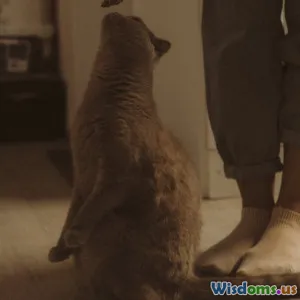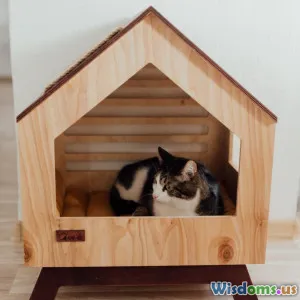
Common Cat Behavior Issues and Solutions
8 min read Explore common cat behavior issues and their solutions to ensure a happy, healthy pet. (0 Reviews)
Common Cat Behavior Issues and Solutions
Cats are exquisite creatures, possessing a dynamic range of emotions and behaviors just like any other pet. However, along with their idiosyncratic charm comes a myriad of behavior issues that can often perplex cat owners. Understanding these behaviors, identifying the root causes, and implementing effective solutions can significantly enhance your relationship with your feline friend.
Understanding Cat Behavior
Before we dive into specific issues, it’s paramount to understand that many common cat behavior problems stem from natural instincts and needs. Cats are wired to hunt, scratch, and maintain a territory, and anything that disrupts these behaviors can lead to negative or problem behaviors.
The Importance of Prevention
Understanding your cat’s needs is essential in preventing behavior problems in the first place. Regular playtimes, proper training, and providing ample resources can make a significant difference. Before resorting to behavioral correction, it's useful to address basic needs:
- Environmental enrichment: Toys, scratching posts, climbing structures, and resting spaces can keep your cat engaged.
- Social interaction: Spend quality time with your cat to satisfy their need for companionship.
Common Cat Behavior Problems
1. Litter Box Issues
Perhaps the most frustrating issue for cat owners is when their feline refuses to use the litter box, instead opting for chosen spots around the house. According to statistics, around 10-15% of household cats experience litter box avoidance.
Causes:
- Medical Issues: Conditions like bladder infections or urinary tract issues can cause associated pains, leading to litter box aversion. Always consult a veterinarian first to rule out any health issues.
- Litter Preferences: Cats may be picky about the type of litter. Changing the litter or box location can lead to significant changes in their habits.
Solutions:
- Medication: If a medical condition is present, appropriate therapy can remedy the problem.
- Litter Box Setup: Ensure you have one box more than the number of cats in your household, and try different litter types to find your cat's preference.
- Maintain cleanliness: Clean the litter box regularly; cats prefer to use clean areas.
2. Scratching Furniture
Scratching is as natural to cats as breathing. They do it to maintain their claws, mark territory, and stretch their muscles. However, a cat's scratching can result in significant damage to your furniture, leading many cat owners to despair.
Causes:
- Instinctual Behavior: Scratching is ingrained in cats as a means to sharpen claws and mark their territory visually and chemically.
- Stress Release: Scratching can also serve as a coping mechanism for stress or boredom.
Solutions:
- Provide Alternatives: Invest in several scratching posts or pads made of materials that appeal to your cat, such as sisal, cardboard, or carpet.
- Positive Reinforcement: When your cat uses the scratching post instead of your sofa, reward them with treats or praise.
- Use Deterrents: Cover furniture with protective materials or use sprays that dissuade scratching.
3. Aggression Toward Humans or Other Pets
Aggression can manifest in cats due to various reasons, including territorial disputes or redirected anger. Recognizing the signs and understanding the triggers is crucial.
Causes:
- Fear or Anxiety: An abrupt change in environment can trigger nervous behavior in cats, resulting in aggression.
- Play Aggression: Sometimes, chronic play aggression stems from insufficient outlets for their hunting instincts.
Solutions:
- Consult an Animal Behaviorist: Seek professional advice if aggression is severe.
- Create Safe Spaces: Ensure each pet has access to separate areas. This helps to reduce perceived territorial threats and allows for personal space.
- Redirect Behavior: Utilize interactive toys that channel their energy positively through play, rather than targeting humans or other pets.
4. Excessive Grooming
While grooming is vital for a cat, excessive grooming may indicate physical health issues or emotional stress. This condition can lead to bald patches and skin irritations.
Causes:
- Stress or Boredom: Cats may excessively groom themselves to self-soothe or relieve stress.
- Medical Conditions: Skin allergies, parasites, or pain can increase grooming behavior.
Solutions:
- Regular Vet Visits: Checkups can help address underlying medical conditions.
- Stress-Reducing Techniques: Create a comfy environment with plenty of toys, safe spaces, and perhaps a calming feline pheromone diffuser.
- Enrichment Activities: Engage your cat with puzzle feeders, climbing shelves, and interactive play sessions to combat boredom.
5. Nuisance Meowing
Persistent vocalization can drive owners to distraction, often emerging when a cat is bored, looking for attention, or feeling unwell.
Causes:
- Hunger: Cats may meow if they’re alerting you that it’s mealtime.
- Loneliness or Attention Seeking: Especially in multi-pet households, a cat may meow for companionship.
Solutions:
- Routine Feeding Schedule: Establish a feeding schedule that they can rely on to minimize attention-seeking sounds.
- Interactive Play: Create engaging interaction times through play to address their social needs and help prevent boredom.
- Consider Consultation: For excessive vocalization that drives you nuts, consult a vet to rule out health issues that may often lead to increased vocalization.
Conclusion
Understanding common cat behavior issues and devising solutions based on the behavior’s root cause is significant in forming a strong bond with your pet while ensuring their happiness and well-being. Every cat is unique; hence, approaches must be personalized. Regular vet visits, enriched environments, and emotional support can work wonders in preventing behavior issues and allowing your feline companions to thrive.
Equipped with these observations and strategies, you’re well on your way to ensuring that both you and your feline friend enjoy a serene and fulfilling life together.
Rate the Post
User Reviews
Popular Posts





















